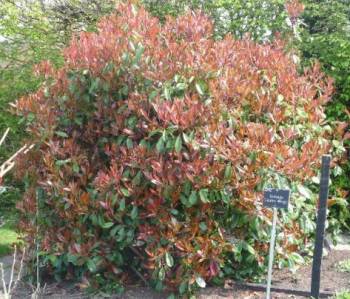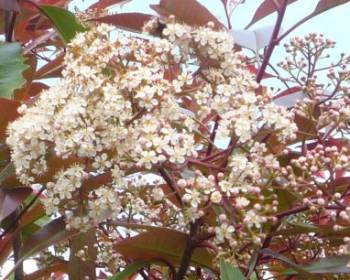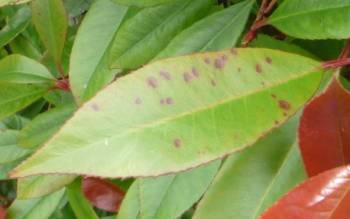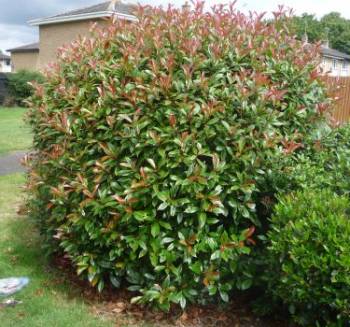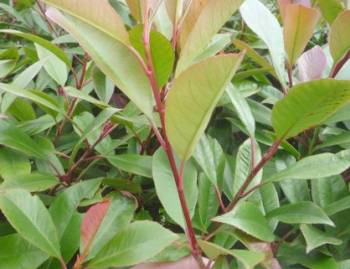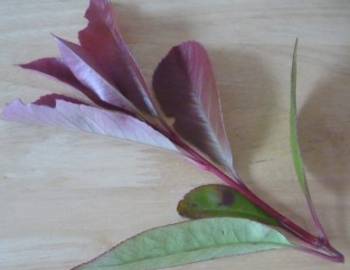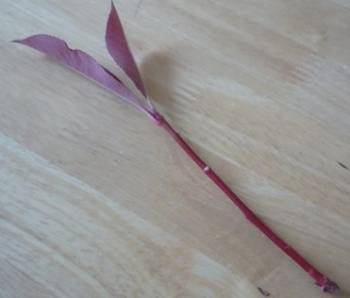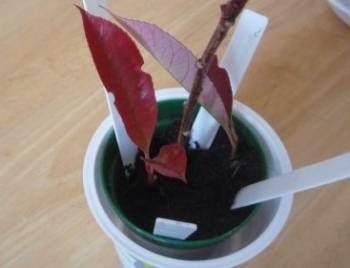RED ROBIN (PHOTINIA)
Article by DavidMarks
The technical name for this shrub is Photinia x fraseri ‘Red Robin’.Photinias, as a group plants are native to North America and Asia. Photiniax fraseri is named because it was first discovered as a seedling in FraserNurseries in Birmingham Alabama in 1943. The particular hybrid ‘Red Robin’was bred in New Zealand and is the most popular of all the Photinias by alarge margin. It retains the red leaves and at the same time is the mostcompact of them all.
This shrub is often under-rated principally because it is so widelygrown. The RHS are quite clear that this is a shrub of great horticulturalvalue, giving it an Award of Garden Merit.
Use the checklist below to decide if a Red Robin is suited to yourpreferences and garden conditions:
- An evergreen shrub which, if not pruned, reaches a height of 4m /13ft with a similar spread. Red Robin grows at a rate of about 30cm /1ft per year when established. It responds very well to pruning and caneasily be kept to a height 1.2m / 4ft.
- It is fully hardy in almost all areas of the UK withstanding temperatures down to -12°C. In protected position, it is hardy to afew degrees lower. See the comments question / answer section (comment dated April 2018) at the end of this article if your Red Robin has lost many of itsleaves during a particularly cold winter.
- Main interest is from bright red leaf tips which turn green as theymature. If left unpruned the previous year, it produces masses of tinywhite flowers in June. The flowers are attractive but the scent is not!
- All soils except heavy clay or waterlogged conditions are suitable.It does best in a deep loam type soil although this is not essential.
- It prefers full sun although also does well in partial shade. Avoidfull shade positions.
- Once established, it rarely requires watering and will toleratemoderate drought.
- A very versatile shrub, it can be grown as a specimen plant, singlyin containers, as a loose hedge or against a wall / fence. It makes a veyattractive standard plant. It is not suitable as a barrier hedge becauseit has no thorns and can easily be parted.
- Disease resistance is good with the exception of leaf spot. See oursection below on pests and diseases of this shrub for top tips aboutavoiding this problem.
- The Dogs Trust does not list Photinia Red Robin as being poisonous to dogs. The are indications however that it can cause problems with grazing animals such as horses and cows.
HOW TO PLANT A NEW RED ROBIN
Follow the steps below to ensure your Photinia Red Robin is planted correctly and in the best position:
- Choose a full sun to partial shade position. The plant needs some aircirculation so although it will thrive against a wall or fence, avoidplanting it in the corner of two walls fences.
- If the soil is heavy or is not free draining addlots of well rotted compost to the area and dig it in well.
- It can be planted all year long if the soil is not frozen and youcan water well when conditions are dry. Mid March to April and mid September to October are the best times to plant this shrub.
- Dig a hole twice the width of the rootball. Sprinkle in a handful of
blood, fish and bone and work into the ground. - Place the plant into the hole, filling in with soil so that it is at the same depth as was in the pot. Fill around the rootball and firm the soil down gently but firmly. Water well to settle the surrounding ground around the rootball.
If you want to grow Photinia Red Robin as a hedge, individual plantsshould be about 75cm (2ft 6in)apart for a quick growing dense hedge. Whengrown against a wall or fence then the plants should be at least 60cm / 2ftfrom the wall or fence.
If they are planted any nearer they may suffer fromlack of moisture at the roots because the base of walls and fences will notreceive as much rainfall as in an open position. Red Robin hedges will never be dense nor will they do anything to prevent intruders.
CARE OF PHOTINIA RED ROBIN
When established a Photinia Red Robin will look after itself. It rarelyneeds watering except in severe drought and will grow quite happily onaverage ground without the need of additional feeds. It will need pruningonce or twice a year to keep it in shape and to size.
For younger plants up to two years old, water if conditions become dry. Atwice yearly feed with blood, fish and bone in spring and autumn will help it toestablish a good root system. Keep the area around the base of the plant freefrom weeds and grass.
Red Robins do have a tendency to drop leaves throughout the year and for those who like to keep their gardens tidy this can mean frequent sweeping up. Where the fallen leaves accumulate at the base of the plant, this will provide an ideal hiding place for slugs and snails.
HOW AND WHEN TO PRUNE RED ROBINS
The frequency of pruning depends on the shape and size you want the plant to grow to. Without pruning, Red Robin will grow quite happily and form a bush sized about 4m / 13ft high and wide after seven years or so.
For those of you who prefer a small shrub then pruning can be done any timebetween March and mid July. We wouldn’t advise pruning after late July becausethe young shoots which appear after pruning may well be soft and easily damagedby early frosts. We would not prune these shrubs until they reach 3 or moreyears old.
Our suggested routine would be an annual prune in early to mid June when the flowers are dead or dying down. If you prune at this time of year you will be likely to have flowers again the next year.

June flowers on a Red Robin plant
Conventional wisdom
says to prune individual stems just above a leaf node. In our experience thoughno special techniques are necessary. In fact we have taken a hedge trimmer toprune ours without any bad effects at all. Whatever method you use, it seems theplant sprouts healthy new red shoots.
A commonly asked question is how far back can I prune an overgrown Red Robin? They can be cut cut back very severely and in our experience they always come back. An out of control plant can be pruned back to 60cm / 2ft high. The best time to do this type of drastic pruning is in May time when the plant is growing strongly.
If you have any cut flowers in the house when you prune your Red Robin, use the red leaves as foliage in the plant arrangement. It looks lovely.
GROWING RED ROBINS IN CONTAINERS
A single Red Robin will grow very happily in a large container. A diameter of 45cm or more is about right.
Fill with either standard multi-purpose compost or a John Innes type loam.
The plant should be fed monthly between mid March to mid August with a handful of blood, fish and bone.It will of course require regular watering. Wait each time until the top 3cm of thecompost is dry and then water well.
Pruning is as described above although you may want to prune more frequently tokeep the plant to shape and an appropriate size for the container. It does helpif the shrub is in a heavy container to avoid it easily being blown over.
PESTS AND DISEASES OF RED ROBINS
Red Robins are healthy plants rarely being attacked by pests. The onefailing is their weakness to leaf spot problems.
LEAF SPOT OF RED ROBIN
The symptoms of this problem are dark red / black spots on the leaves. Affected leaves eventually fall off and in bad cases the plant can severely affected. The latest research indicates that in most cases the damage is caused by damp, humid and / or cold conditions rather than disease.

Where the plant is only partially affected the solution is to remove spottedleaves and burn them as soon as they are noticed. Where the damage is moresevere you have two choices:
- prune back hard in mid May, remove all the prunings and in alllikelihood the plant will bounce back with new red growth in a month orso.
- accept the fact that the position of the plant is the cause, dig itup and plant something there which can cope better. You may want to takecuttings before you do this, read our section below on propagation.

We have noticed that it is the shaded side of plants which are most affected.The above photo shows the sun side of a Red Robin which is totally unaffected byleaf spot. The shade side was affected, but only to a minor degree.
HONEY FUNGUS AND RED ROBIN
This fungal disease spreads underground from plant / tree to other other plants / trees. It attacks the root system and causes it to gradually be unable to absorb moisture and nutrients. The key signs are a generally unhealthy plant with white fungus appearing near ground level on the stems. If you dig carefully to roots under the ground the white material will be clearer on the roots.
In all likelihood your Photinia will not be the only shrub affected, although Photinias are particularly susceptible. We suggest you research this disease online / in books because it is extremely difficult to eradicate. Often the only course of action is to dig up and burn the affected shrubs and plant those which are resistant to honey fungus.
HOW AND WHEN TO PROPAGATE RED ROBINS
Red Robins are easy to propagate and the chances of success, even for very amateur gardeners, are very high. The following guidelines will ensure the best outcome:
- Take the cuttings in late July to early September time. If the bushis some distance away take a plastic bag to store the cuttings in andprevent moisture loss. Also, take the cutting longer than needed andmake the final cut (see below) when you are ready to plant the cutting.This will minimise the cut healing over which makes rooting more difficult.

A stem suitable for cutting
- Select a stem which is about 2mm thick and cut it off just below a
leaf node toleave a 8cm / 3in cutting. The cutting should be semi-ripe whichmeans not new soft growth and neither hard old growth. Somewhere inbetween is best.

The cutting unprepared
- Remove the lower leaves of the cutting

Lower leaves removed
- Fill an 8cm wide pot with multi-purpose and insert three evenlyspaced cuttings in it about 4cm / 1.5in deep.

Cuttings in a pot of compost
- Gently firm the compost down around the cuttings to ensure it is ingood contact with the stem. You may want to take six cuttings and usetwo pots, to ensure the best chance of success.
- Place the pot in a shallow tray / bowl of water for half an hour sothat it absorbs a good amount of water but the top part is notwater-logged.
- Remove the pot from the water and cover it with cling film or asmall plastic bag and support it so that it does not touch the leaves.Plant markers are good for this purpose.
- Place the pot in a shaded and cool (but not cold) position.
The cuttings should begin to root in two to three weeks and at this pointremove the plastic bag. The cuttings should then grow and the best time toplant them out in their final position is next April / May when the dangerof frost has passed.
During that time keep the rooted cuttings in a cold greenhouse or outsidein a shaded position out of the way of harsh weather. They may well needwatering, keep the compost slightly moist but not waterlogged.
Other similar shrubs in this series include Ceanothus,
Choisya, Hebe, Skimmia, Magnolia, Mahonia, Mock Orange, Lilacs, Potentilla and
Rose of Sharon (hibiscus syriacus). For the full list, click the Shrub Index link below.
PHOTINIA RED ROBIN SUMMARY
Below we list the key strengths and weaknesses of Photinia Red Robin.
| HARDY | |
| CLAY SOIL | Yes, if improved (see above) |
| SANDY SOIL | Yes |
| DRY SOIL | No |
| SHADE | No, partial, full sun |
| EVERGREEN | Yes |
| EASY CARE | |
| SMALL GARDENS | No |
| POT / CONTAINER | Yes |
| FLOWERING | |
| FLOWER TIME | Not relevant |
